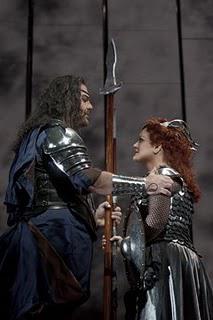
Father knows best: Bryn Terfel and
Deborah Voigt in Die Walküre.
Photo © 2011 The Metropolitan Opera
The best thing about Robert Lepage's new staging of Die Walküre(which premiered at the Metropolitan Opera on Friday night) is that the performances are so absorbing that you simply forget about the hype, about the problematic multi-million dollar set, and get pulled into the great drama of the Wälsungs, Wotan, and Brunnhilde.
The Met has assembled a strong cast. Deborah Voigt's voice has widened and developed a steely edge, both of which helped her Brunnhilde. She sings the role rather than screams through it, tossing off ringing battle-cries and achieving real tenderness in her lengthy scenes with Bryn Terfel's Wotan.
The Annunciation of Death (taken at a very slow tempo by James Levine) was her best moment of the evening, and you could see the interplay of loyalty and emotion as Brunnhilde discovered her budding humanity. The low point: a stumble-and-tumble at the bottom of the set, just four minutes into Act II. Ms. Voigt recovered adroitly, and it did not affect the rest of her performance.
Mr. Terfel is a dark and stormy Wotan. The voice is just a shade under-sized for this part, never opening out into the smooth, ardent richness that is heard in the best interpretations of the King of the Gods. However, he is a strong actor, and is willing to drop all the way down to a clear pianissimo in the most anguished moments. His monologue (helped by some interesting visuals) was a riveting experience, even though his cries at the end had trouble getting over the raging orchestra.
Jonas Kaufman' Siegmund (the tenor's first Wagner performance in New York) was the best part of this cast. He was sure and steady, cautious at first and then opening out his big voice halfway through the act. His ringing cries of "Wälse" and perfect German diction make him the best Siegmund at this house in many years. The final cry of the act rose to an ecstatic, swelling high note. Then, he held it, riding over the crashing wave of the orchestra and drawing a storm of applause.
There were two Sieglindes on the stage last night. Eva-Maria Westbroek was suffering from illness, although it did not appear to affect the strength of her singing. Her cover, Margaret Jane Wray, was excellent in the second and third acts. Hunding (who appeared with a posse of lantern-swinging hunters as he chased Siegmund) was sung with power and menace by Hansr-Peter König. Mr. Lepage's decision to make the Neiding warlord an older, almost grandfatherly figure made the villain even more menacing.
Stephanie Blythe was a regal Fricka, appearing on a red leather throne surrounded by supplicating rams. Ms. Blythe's scene with Wotan was another highlight, bringing out the complexities of power dynamics within their marriage. Her final address to Brunnhilde was a melodic feast, as her sturdy mezzo dripped scorn upon Wotan's bastard daughter.
Much has been made of Mr. Lepage's set, the multi-million dollar device dubbed "The Machine". These two dozen spinning, moving, computer-controlled grey planks that serve as a canvas for digital imagery of the natural world, and as a stormy backdrop for a spectacular Ride of the Valkyries. Here, the Canadian director uses this high-tech gizmo to recreate the birch forests and rocky landscapes of Mr. Lepage's native land.
The opening image of the forests outside Hunding's hut recalled the paintings of Tommy Thompson and the Group of Seven. The hut itself looks like a winter cottage in the Laurentians, with wooden beams and a realistic ash-tree. The first scene of Act II evoked the rocky Canadian Shield. The Valkyrie Rock recalled the high Rockies of the west, complete with falling avalanche, and the Magic Fire is ignited digitally, on a lava waste. The effects are an impressive, and a vast improvement on Das Rheingold.

